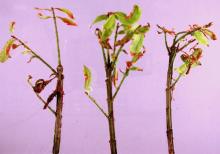Cause Pseudomonas syringae pv. syringae, a bacterium. Factors that favor the disease include wounds, frost damage, soil pH, poor nutrition, and infection by other pathogens. Sources of bacteria include old cankers, healthy buds, and epiphytes on leaf surfaces, weeds, grasses, and even soil. Bacteria can spread by wind, rain, insects, and infected nursery stock. Although the bacteria survive on the outside of the plant they must get inside and multiply in the space between plant cells (apoplast) to cause disease. These pathogenic bacteria inject several proteins and small-molecule toxins to get past host immune mechanisms. Once inside, the bacteria induce a watery, nutrient rich environment between the plant cells where they can multiply and continue colonization of the plant tissues. Bacteria also produce a protein that acts as an ice nucleus, increasing frost wounds that bacteria easily colonize and expand.
Symptoms Only black-tip or shoot dieback has been reported on Euonymus, but workers in Oregon also have associated leaf spots with this bacterium.
Cultural control
- Remove and destroy infected leaves or plant debris.
- Space plants for good air circulation.
- Avoid high nitrogen fertility that promotes excessive growth.
- Protect plants from extremes of weather early in the season. Plastic shelters have been as good as or better than chemical methods against the same disease on other crops.
Chemical control Bacteria resistant to copper products have been detected frequently in many nurseries.
- Badge X2 at 1.5 to 2 lb/A. Group M1 fungicide. 48-hr reentry. O
- CuPRO 5000 at 1.5 to 5 lb/A but only up to 2 lb/A when new growth is present. Group M1 fungicide. 48-hr reentry.
- Junction at 1.5 to 3.5 lb/A. Group M1 + M3 fungicide. 48-hr reentry.
- Monterey Liqui-Cop at 3 Tbsp/gal water. H
- Nu-Cop 50 DF at 1 lb/100 gal water. Group M1 fungicide. 48-hr reentry.
Reference Canfield, M.L., Baca, S., and Moore, L.W. 1986. Isolation of Pseudomonas syringae from 40 cultivars of diseased woody plants with tip dieback in Pacific Northwest nurseries. Plant Disease 70:647-650.



